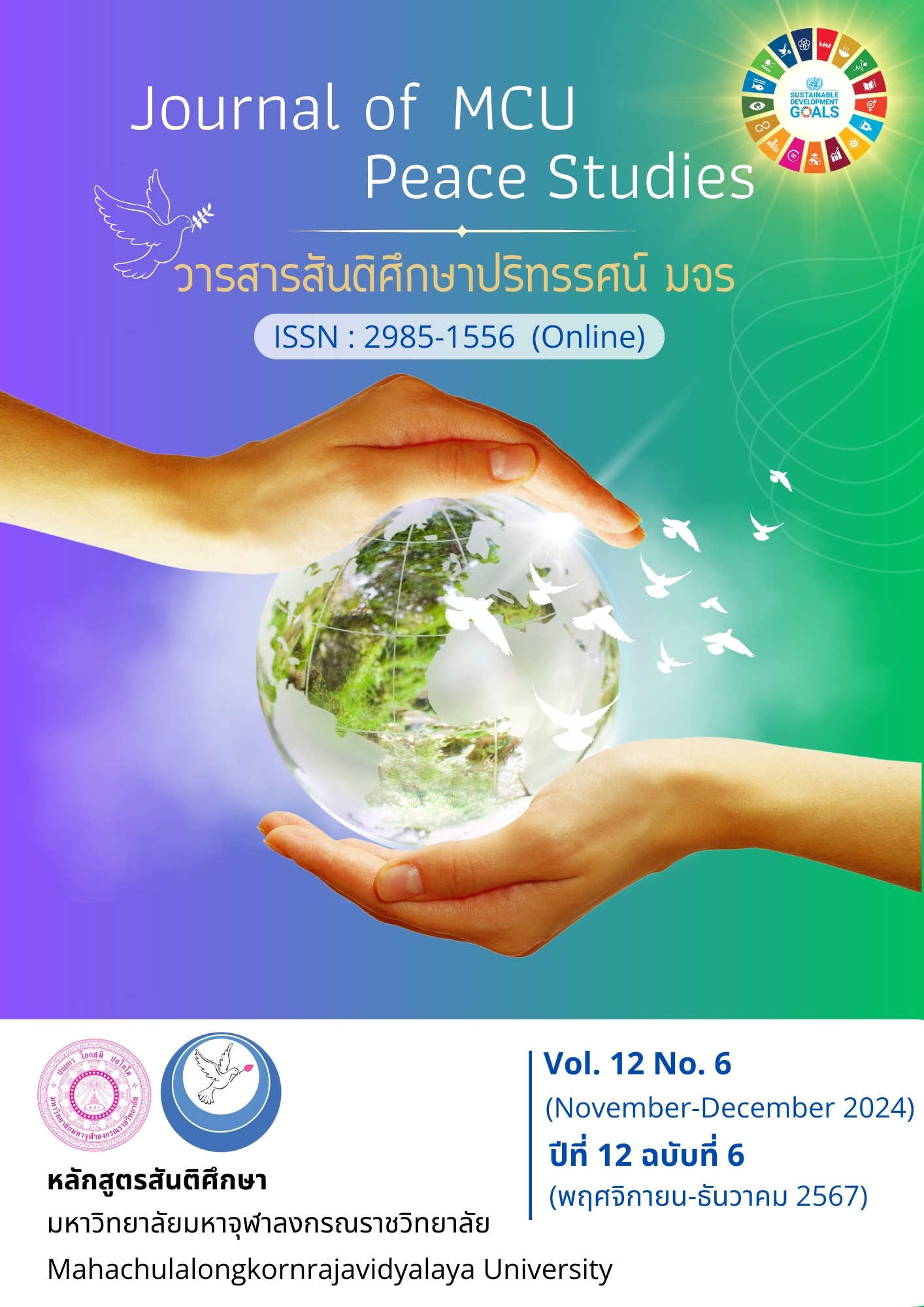Participation in the Development of Biodiversity Areas in the Community Ecosystem
Main Article Content
Abstract
The research article aimed to: 1) investigate participation in developing biodiversity areas within the community ecosystem; 2) develop activities and biodiversity areas in the community ecosystem through community participation; and 3) promote participation in the development of biodiversity areas in the community ecosystem. The study employed documentary research, qualitative research, and action research approaches. Qualitative data were collected through focus group discussions with 18 key informants and in-depth interviews with 12 participants. An exchange platform was organized to discuss guidelines for promoting the participation process in area development, as well as a model for enhancing participation in biodiversity areas within the community ecosystem. The collected data were analyzed using explanatory and descriptive methods.
From the study, the following results were found: 1) The development of biodiversity within the community ecosystem across the three communities emphasizes legal participation, collaboration with relevant organizations and Local Administrative Organizations, and cooperation between the government and communities. These efforts aim to sustainably manage community forests and create a balance between nature and the lifestyles of people in Uthai Thani province. 2) The development of activities and biodiversity areas in the community ecosystem through community participation includes: (1) Learning resource activities within the area, such as occupational development, sustainable community career promotion, and forest protection. These activities include community forest boundary marking, forest patrols, building patrol pavilions, forest care and maintenance, and raising awareness about forest conservation; and (2) Activities to manage local biodiversity, including increasing green areas within the community to promote a green city, establishing the ‘Rom Sak’ market to conserve plant genetics, supporting organic farming, preventing and mitigating forest fires, and conserving local natural resources. 3) To promote participation in the development of biodiversity areas within the community ecosystem, the following activities need to be implemented to foster diversity in the area: (1) guidelines for raising awareness in developing and conserving community forests; (2) guidelines for implementing activities; (3) guidelines for enhancing and developing learning resources; (4) activities to raise awareness; (5) guidelines for raising awareness in conservation; (6) learning activities for community learning resources; and (7) enhancing community awareness to preserve the area around Huai Kha Khaeng Natural World Heritage Site in Uthai Thani province. These seven steps form a model to encourage participation in the development of biodiversity areas within the community ecosystem.
Article Details

This work is licensed under a Creative Commons Attribution-NonCommercial-NoDerivatives 4.0 International License.
Views and opinions expressed in the articles published by The Journal of MCU Peace Studies, are of responsibility by such authors but not the editors and do not necessarily reflect those of the editors.
References
Chaiprasart, P. (2016). Biodiversity and Conservation of Medicinal Plants at Educational Nature Trails in Bhumibhol Dam, Tak Province. (Research Report). Phitsanulok: Naresuan University.
Chuchip, K. (n.d.). Biodiversity: The Foundation of Sustainability for Local Communities in the Western Forest Complex. Retrieved May 3, 2023, from http://www3.rdi.ku.ac.th/exhibition/52/08-intregration/nikhom/intregration_00.html
Duanglampun, Ch. et al. (2013). Development of Green Spaces under the Concept of Ecological Communities: A Case Study of Mae Jo Municipality, San Sai District, Chiang Mai Province. Proceedings of the 2nd National Conference on Forest Ecology Research Network in Thailand: Ecological Knowledge for Restoration. Proceedings of the 2nd National Conference on Forest Ecology Research Network in Thailand. (pp. 384-395). Kasetsart University, Faculty of Forestry; Forest Ecology Research Network in Thailand; Mae Jo University; Department of National Parks, Wildlife, and Plant Conservation; Office of the Higher Education Commission.
Junsontima, K., & Intachaiwong, O. (2015). Management for Participation in Natural Resource by Balance and Sustainability Case Study: Community Ban Khlonghuaiwai, Mae Poen, Nakhon Sawan. Journal of Thai Ombudsman, 9(1), 58-79.
Office of Bioeconomy Development (Public Organization). (2018). Handbook for Local Biodiversity Management. Bangkok: Office of Bioeconomy Development (Public Organization).
Sonloy, N. (1999). The Management Guideline for Bang Ka Chao Green Area Project in Prapadang District, Samutprakarn Province. (Master’s Thesis). Mahidol University. Nakhon Pathom.
Viruhpintu, S., Khwanboon, Th., & Yoelao, W. (2016). Biodiversity of Avian and Wildlife for Ecotourism: A Case Study of ChomPhu Sub-District, Noen Maprang District, Phitsanulok Province. Proceedings of the 3rd National Meeting on Biodiversity Management in Thailand (pp.23-39).
Wanlayangkoon, M. (2014). Corporate Social Responsibility Communication Strategy of Bank for Agriculture and Agricultural Cooperatives. (Master’s Thesis). National Institute of Development Administration. Bangkok.
Yasa, U., & Tangkittipaporn, J. (2014). Sustainable Development of Green Space in Chiang Mai Municipality. Journal of Community Development and Life Quality, 2(3), 233-243.

